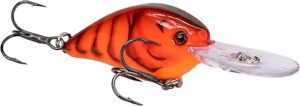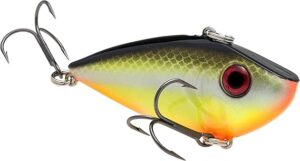Cold Water Crankbait Tactics
Cold water fishing poses its unique set of challenges. As temperatures drop, fish behavior changes significantly. Their metabolism slows down, influencing their feeding habits and movement patterns. Fish don’t waste energy chasing bait like they might in warmer conditions. That’s why understanding these behavioral shifts is key to an effective fishing strategy.
Traditional fishing techniques often fall short in cold water. The techniques designed for active, warm-water fish don’t account for the lethargy fish exhibit in colder environments. Relying on these strategies in cold weather can leave you empty-handed after a long day. It’s essential to adapt to the environment.
Crankbaits, with their ability to mimic various prey, become an indispensable tool in colder waters. They’re particularly effective because they can be manipulated to work at different depths and speeds. By adjusting the retrieve to a slower pace, anglers can mimic the slower-moving prey, enticing fish that aren’t willing to put up much of a chase.
Using crankbait efficiently requires more than just throwing out the line. It’s about using the right tool for the unique conditions like temperature, water clarity, and fish behavior. Leveraging crankbait under these conditions not only increases the chances of a catch but also adds a strategic element to your fishing game.
Understanding the science behind crankbait fishing is more than knowing what bait to use—it’s about timing, technique, and coaxing that fish into making a move. In cold waters, patience and precision pay off.
Choosing the Right Crankbait: A Guide to Shapes and Colors
Selecting the right crankbait can make or break your day on the water. It’s not just about what’s available in your tackle box but about picking the perfect combination of shape and color. Different crankbait designs play into the natural feeding habits of fish, imitating the size and silhouette of the prey they chase.
Shapes aren’t just aesthetic. Lipless crankbaits, for instance, often work best in shallower waters, while deep-diving models suit well for fishing in lakes with drop-offs. Match the crankbait design to the depth and the environment you’re fishing in to reel in more catches.
Color is another critical aspect. In clear waters, natural hues like silver or shad patterns often yield better results. On the flip side, if you’re dealing with murky waters, brighter colors like chartreuse or orange help attract attention. The goal is to strike a balance; your crankbait needs to stand out without appearing unnatural.
There’s some psychology involved here as well. Fish react differently depending on water conditions and the color spectrum visible to them in those conditions. Lighter colors may mimic a distressed baitfish under certain lighting, whereas dark and bold colors can catch the eye against dim underwater backgrounds.
It’s also important to consider the fish species you’re targeting and their natural prey’s color. Understanding these aspects can significantly increase your efficiency. Research local conditions or talk to other anglers to get quick insights into what works best.
Ultimately, crankbait fishing in cold water is about pairing the right lure with the right conditions, making sure the bait’s actions and appearance match what your target fish would naturally pursue. This strategic approach sets the stage for a successful angling experience.
Perfecting Your Crankbait Retrieval Technique
In cold water conditions, the way you retrieve your bait can significantly impact your success. Fish tend to be more sluggish when it’s chilly, so a slower, more deliberate retrieval often does the trick. Rushing your reel might just scare them off, leaving your bait unscathed.
Understanding the importance of retrieval speed is key. A slow and steady approach mimics the movement of a struggling prey—which is exactly what lures in those idle fish. It’s like presenting an easy meal they can’t resist, even when they’re conserving their energy.
A variety of retrieval patterns can be employed to mimic different prey actions. The pause-and-go method can be a game-changer. Keeping your bait still for a few moments can intrigue fish into striking. It’s about creating an illusion of vulnerability, triggering their predatory instincts.
By observing fish reactions—like sudden surges or hesitant approaches—you can tweak your technique in real-time. If the slow roll isn’t cutting it, try adding a few jerks in the retrieve. Small changes can often lead to significant differences in how fish respond to the bait.
Real-time adjustments are crucial. Fishing isn’t a static game; it requires attention and adaptation. Some days, what worked last time might not get a nibble. Stay flexible and ready to experiment with different retrieval speeds and patterns to find what works best that day.
Employing these techniques not only involves skill but also patience. Learning to read fish behavior and adjusting your tactics on the fly can greatly enhance your crankbait success. More than just casting, it’s about the rhythm and subtlety in each movement.
Location, Location, Location: Finding the Optimal Fishing Spots
Identifying where to cast in cold water is half the battle. Fish tend to huddle near structures or deeper areas where temperatures are more stable. This means pinpointing those key spots can lead to more bites.
Rivers, lakes, and reservoirs each offer unique opportunities and challenges. In rivers, the fish may linger near natural covers like rocks or fallen trees. In lakes, look for drop-offs, ledges, or the mouths of tributaries where fish gather due to changes in depth and current.
Using technology enhances your ability to find prime locations. Sonar systems can be your underwater eyes, showing where fish might be congregating. GPS devices help you map out and return to successful spots time and again.
Natural cover plays a vital role in fish habitat. Weeds, stumps, or submerged logs offer safety for fish and food opportunities. Knowing how to identify these areas can add a substantial advantage, increasing your chances for a great catch.
An often overlooked aspect is understanding the fish’s daily patterns in the waterbody you’re targeting. Fish movements can be surprisingly predictable, based on factors like water temperature and light levels.
Being adaptable to changes in location based on fish movements or water level changes is equally important. Whether you’re in a boat or on the shore, staying mobile and willing to relocate can help make the most out of your fishing session.
Weather and Seasonal Influence: Timing Your Fishing Outings
Weather patterns have a big say in when fish are active and when they’re not. Cold fronts can slow down fish feeding, making it tougher to get bites. But once the front passes and temperatures stabilize, fish might go on a short feeding frenzy, and that’s when you want to be out there.
Seasonal changes are a game changer, too. As seasons shift, fish adjust their habits, moving to different depths and changing feeding patterns. Spring and fall can see fish more active as they prep for spawning or stock up for winter.
Timing your trips around these periods can boost your odds. Early mornings or late afternoons are traditionally good times because light levels and temperatures are more moderate. Fish are often closer to feeding zones, making it prime time for crankbait fishing.
Keeping an eye on the weather forecast helps in planning the perfect outing. A warming trend in cold water seasons can spike fish activity, while sudden drops might slow things down.
Understanding local patterns can also provide insights. Certain species may react differently based on historical weather patterns for your region, so tapping into local knowledge or records can be beneficial.
The interplay of weather, season, and fish behavior is intricate, but mastering it can significantly increase your catch rate. Being prepared and timing your fishing trips around these natural cycles will enhance your experience and success.
Safety and Conservation: Best Practices for Ethical Fishing
Fishing isn’t just about the thrill of the catch; it’s also about preserving ecosystems for future generations. Ensuring a safe environment for both anglers and aquatic life starts with respecting fishing regulations and local guidelines.
The principles of catch-and-release are fundamental. Proper techniques help minimize harm to fish, whether you’re removing hooks carefully or returning them to the water efficiently. Using barbless hooks and wetting hands before handling fish are simple practices that make a big difference.
Conservation efforts don’t stop there. Reducing your impact involves taking care of the surroundings, like cleaning up litter and using non-toxic tackle. Sustainable practices help maintain the health of the waterway and the fish populations within it.
Responsible anglers contribute to waterway health by staying informed about local conservation projects. Participation in or support for these initiatives can lead to positive changes and improved fishing experiences.
There’s more to fishing than just pursuing the biggest catch. It’s about fostering an environment where fish thrive and you can enjoy a guilt-free, rewarding outing. Prioritizing sustainability ensures that fishing remains accessible and enjoyable, not just today, but for years to come.




